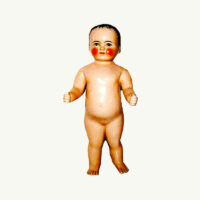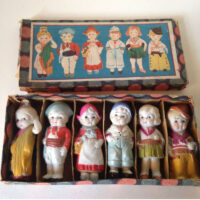To be or not to be a “Frozen Charlotte”
I have collected small dolls for years and particularly love the frozen bisque dolls from 1920-1940s from Germany and Japan. I went crazy buying them in antique stores around the country and on eBay over the years but have had a hard time finding any info on the internet or doll books about them… well the reason was I was using eBay as the reference which uses any small bisque frozen doll whether it is jointed, shelf sitter, Penny or Frozen and calls them all “Frozen Charlottes”. THIS IS INCORRECT!
Frozen Charlottes have a lot more info on them- The body must be frozen! No jointed arms to be a frozen Charlotte or Charlie.

Frozen Charlie
Frozen Charlotte (doll)
From Wikipedia, the free encyclopedia
Description
The Frozen Charlotte doll is made in the form of a standing, naked figure molded all in one piece. These dolls may also be seen described as pillar dolls, solid chinas or bathing babies[1]. The dolls ranged in size from under an inch to 18 inches plus. The smallest dolls were sometimes used as charms in Christmas puddings[1]. Smaller sizes were very popular for putting in doll’s houses. Occasionally versions are seen with a glazed china front and an unglazed stoneware back. This enabled the doll to float on its back when placed in a bath[2].
They are also made in bisque, and can come in white, pink-tinted, or, more rarely, painted black[1]. Some rare examples have moulded chemises. Male dolls (identified by their boyish hairstyles) are called Frozen Charlies.
References
^ a b c Coleman. Dorothy S., Elizabeth A. and Evelyn JK.; The Collector’s Encyclopaedia of Dolls Volume One, (USA, 1978)
^ Eaton, Faith; Dolls In Colour (London, 1975)
Frozen Charlie
For other uses, see Frozen Charlotte.
Frozen Charlotte is a name used to describe a specific form of china doll made from ca. 1850 to ca. 1920.
Manufactured as early as 1850, these intriguing bisque/china/porcelain dolls were originally produced as VICTORIAN BATHING DOLLS called “FROZEN CHARLOTTE”; so named from a song about a Victorian era girl who went out dancing with her beau to a ball at a nearby inn. She left without her wrap against her mother’s wishes and froze in the snow.
The dolls I have more of are actually “Penny” dolls with the easiest to find on the market are from Japan but there are wonderful versions from Germany and France as well. These dolls are usually made in bisque and are painted in bright colors. Since the bisque is not fired a second time after painting the paint wears off easy. Value is more based on details, condition of paint and arm positions, with crossed arms the most unusual. The dolls were often sold in sweet shops for a penny thus the name. The dolls were also sold in theme sets such as a wedding party complete with a little church or a group of cowboys, cowgirls and Indians. It is more difficult to find these still in sets but they do occasionally show up. These are fun to collect since there are so many varieties out there. I like to display in old print trays with a sheet of glass on front so I can hang on wall.

Penny Dolls Countries Set



What kind of paint was used on the dolls pictured above? Can I use a spray sealer on them so the paint won’t rub off?
Hi Carole,
You could use sealer but that would be altering the original state. I would keep as is and just not use in hard play as they were with children. Value is based a lot on the quality of remaining paint.
Terri @ Art Of Toys
Sorry for delayed response- if you have more questions contact me at arttoyssac@gmail.com which is checked daily